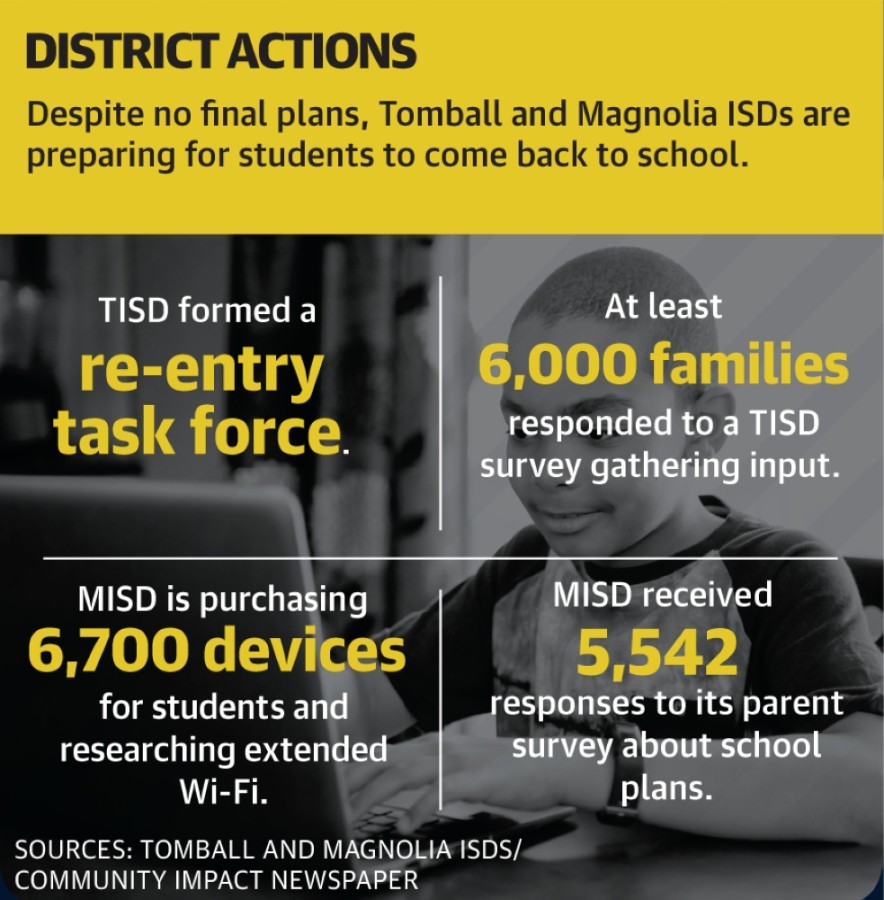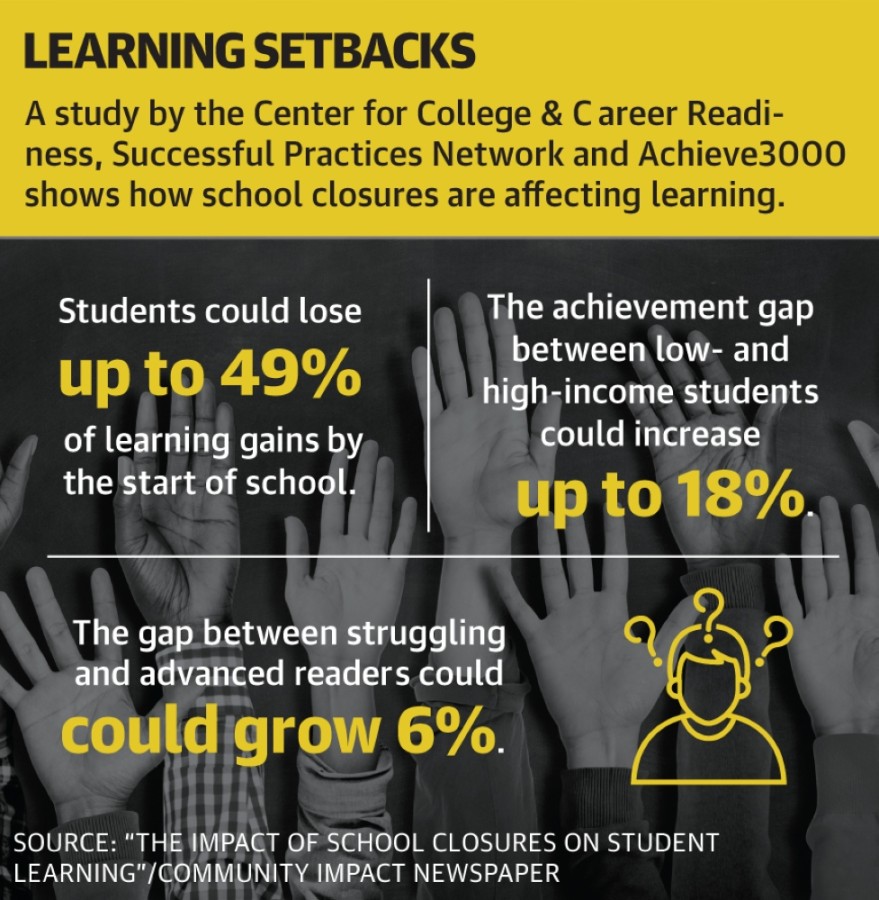Students could see about five months of lost learning by the time they go back to school this fall as a result of forced school closures this spring and the usual summer setback in learning, according to a national study examining how spring school closures affected student learning.
“We think learning loss by back to school may be up to a high of 49%,” said Stuart Udell, an author of the study and the CEO of Achieve 3000, a supplemental reading program used nationwide, including in Tomball ISD.
School facilities in the Greater Houston area closed in mid-March to help slow the spread of the coronavirus, and districts were forced to roll out remote learning quickly to continue the school year. Now, as districts look forward to school resuming in August, guidelines released by the Texas Education Agency on June 23 offer districts two options to deliver instruction remotely alongside on-campus learning to receive state funding in 2020-21, including synchronous—or real-time—and asynchronous—or self-paced—remote learning.
“I think for most kids, the distanced learning has been and will continue to be clearly less effective than traditional classroom-based instruction, I think, especially in Tomball ISD where I believe the quality of instruction is very good in the classroom,” said Lawrence Taylor, a Creekside Forest Elementary School parent, during the June 9 board of trustees meeting.
As of press time June 30, Tomball and Magnolia ISDs had not announced final plans, as the districts said they are awaiting further state guidance. However, both districts have mentioned a possible hybrid model, offering classroom and online learning.
“Our intent in fall 2020 and beyond is to try and return to some sort of normalcy that we are accustomed to in a brick-and-mortar-delivered means of instruction. I think that’s an important thing that our community needs to hear,” TISD board President Michael Pratt said June 8.
Districts talk fall plans
Jean Sharp, board member of the Digital Learning Collaborative—a national group dedicated to best practices in digital learning—and chief academic officer of Apex Learning said districts should plan for multiple scenarios this fall, anticipating rolling closures from the pandemic. She said she believes there are three options for instruction: classroom, online or a blend of the two.
“We shouldn’t go into the new school year anticipating that it’s just business as usual because it won’t be,” she said.
The TEA guidelines updated June 25 state students and families will choose how they “attend” school, be it an on-campus, remote or hybrid model, where there is an intentional mix of on-campus and remote learning.
“Based on our parent survey, our parents want to have their children return to school this fall and have as much as a normal school year as possible,” MISD Director of Communications Denise Meyers said in an email.
Additionally, MISD Superintendent Todd Stephens said during a June 8 board of trustees meeting the district is in “uncharted waters” with planning for the next school year.
“The bigger issue is going to be mixing online and [in-person] learning,” he said. “We did have parents that said, ‘I don’t know if my kid can come back for everything.’”
To prepare for the fall, Meyers said the district is purchasing 6,700 student devices and researching how to provide extended Wi-Fi coverage to families in need. MISD is also modifying its professional development this summer so teachers will be better prepared for a variety of learning environments.

“All staff will use online instruction in their daily activities so that, in the event of a school closure, teachers and students will be ready to switch over to a 100% online environment,” Meyers said.
TISD would not comment further on its preparations for the fall.
“Tomball ISD will open in August and is considering all learning options at this time, including in-class direct instruction, a hybrid model of learning and/or remote learning,” Superintendent Martha Salazar-Zamora wrote in a letter June 24.
Education reimagined
To consider how school can best resume, TISD has formed a re-entry task force made up of the executive team, central office administration and campus administration, Salazar-Zamora said June 8.For example, the task force is considering mask wearing, spacing desks 6 feet apart, distancing on buses, controlling traffic flow through buildings, limiting outside access to visitors, limiting transition times, whether to take daily temperatures, and what to do about shared spaces such as playgrounds and cafeterias, she said.
Neighboring districts, such as Spring ISD, have modified calendars or the length of the school day. SISD’s 2020-21 calendar runs August to June.
Salazar-Zamora said June 8 there are no plans for the district to modify its approved calendar, although plans are subject to change.
“I’m not saying that an intersessional calendar, more of a year-round instruction isn’t good, but currently for our district and our community I feel that we can continue with what we have put forward,” she said. “And of course, if we have a need to have to be out [for COVID-19] ... we’ll certainly adapt to it at that point.”
To help districts reopen, the TEA announced June 9 it would distribute personal protective equipment—masks, gloves, thermometers and hand sanitizer—to every district based on student and staff counts.

“We know there’s a high degree of interest in public health guidance in terms of what the public health rules will be for on-campus instruction, but ... it’s a rapidly changing public health situation, so we are unable to give final guidance today on on-campus instruction,” Commissioner of Education Mike Morath said June 23 to superintendents.
Salazar-Zamora wrote June 24 TISD hopes to return to school with basic health and safety measures, including hand-washing, hand sanitizer, self-health screenings, fewer students on buses and possible mask requirements.
“None of us want to start school in the manner in which we may have to,” she said June 9.
Learning outcomes
If remote learning is offered again, Sharp said she believes it will be more rigorous than this spring.“I think what has happened this spring is not what reflects the best of online learning. We had to make that transition so quickly to have students all working from home,” she said.
TEA remote guidelines require districts offer a minimum number of daily instructional minutes, take daily attendance, use grading policies consistent with on-campus learning and submit information to the TEA about their plans.

Udell said he believes using the summer break to make up the learning loss from COVID-19 and providing additional support to struggling students this fall is key for student success. He said the national study on school closures showed the difference in achievement between struggling and advanced readers grew 6% following school closures and about 4% between low- and high-income readers.
“We got [learning] wrong in the spring a lot of places because of the urgency of finding a solution quickly,” he said. “We have to make this transition well, or we may have generations that are just less prepared for the future.”
Dylan Sherman contributed to this report.





